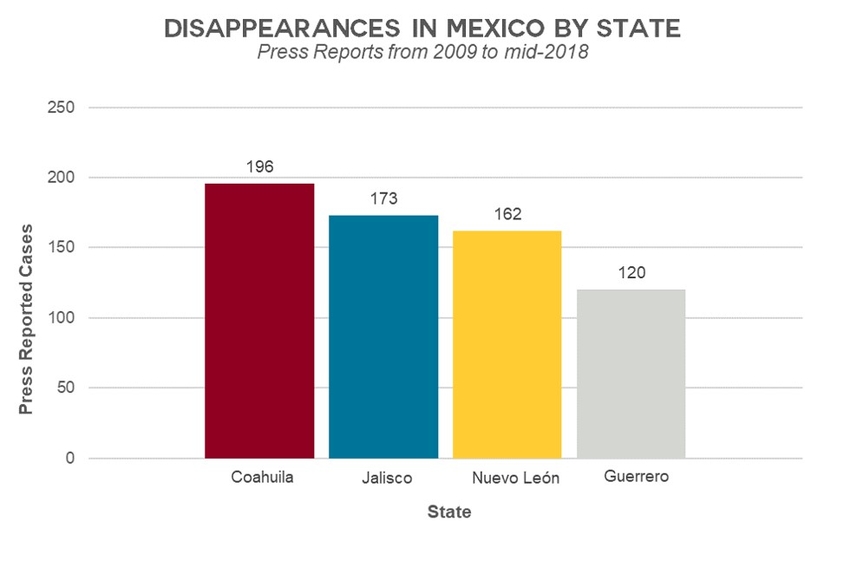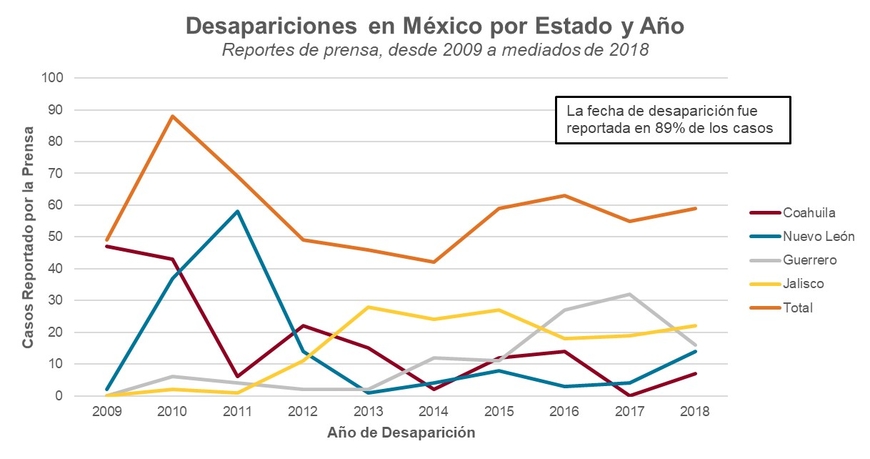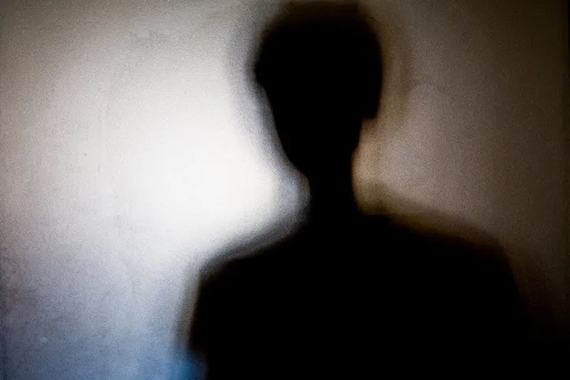Description of the Database
Using our methodology process, we identified 651 cases of disappeared victims published online by 227 press outlets during the nine-year span. To prevent the skewing of numbers in the press database during the analysis, we choose to exclude press reports from two highly publicized cases -- the case of the 43 students disappeared in Ayotzinapa, Guerrero, in 2014, and the case of three film students who disappeared in Guadalajara, Jalisco, in 2018.
The number of articles published about each disappeared person in our database, aside from these two high profile cases, spanned from 1 to 23 articles. While this range suggests some major in-depth reporting, and the average number of articles per case was five, in nearly a quarter (24%) of the reported disappearances, the press published only one article about the case. Large numbers of articles about a single disappearance case, which might represent investigative reporting or follow up, were rare. The most highly reported disappearances -- those with the most articles written about them -- tended to be in cases in which families or groups disappeared, which related to public figures, or highly sympathetic victims such as small children.
The press database further demonstrates significant underreporting of named disappearance cases in the four states we studied, despite thousands of disappearances known to have occurred in each of these states. There are various reasons for this discrepancy, including fear, editorial and journalistic decisions about newsworthiness. We found an average of 163 disappearance cases per state that were reported by the press about named victims. The state with the highest number of cases reported was Coahuila, which had a total of 196 reported cases. The state with the fewest disappearances reported about named victims was Guerrero, with 120 reported cases (Figure 1) during the period we studied.

While press reports provided limited information overall, they still told us a great deal. The following is an analysis of trends and observations of data the Mexican press did report about disappearance cases. For state-specific summaries, visit the individual state sections on this site.
Number of press reports
Press reports of disappearances appeared at a fairly consistent, if low, level between the years 2009 to mid-2018, averaging 58 reported victims per year, with a notable spike in reported cases in 2010 and 2011. As seen in Figure 2, distinct trends emerged in reporting regionally and by state. Press reports in Coahuila and Nuevo León, two contiguous northern states, accounted for the spike in cases during 2010 and 2011, when disappearances were highest in the border region. In Guerrero, reports of disappearances were concentrated from 2016 to 2018 (the 2014 case of the 43 students was not included in this analysis), and in Jalisco, higher incidences were reported between 2013 and 2018, following the upswing of violence there.

Where were the victims disappeared?
Five municipalities had the highest reported disappearances in these four states during this period:
-
Piedras Negras, Coahuila (44 cases/10%);
-
Monterrey, Nuevo León (33 cases/8%);
-
Lagos de Moreno, Jalisco (29 cases/7%);
-
Torreón, Coahuila (27 cases/6%);
-
Chilapa de Álvarez, Guerrero (20 cases/5%).
Disappearances tended to be reported more often in city centers; however, supporting the Observatory’s prior research, the press reports did suggest that disappearances were widespread and deconcentrated among municipalities in each state.
The reports shed light on the location of the disappearances. When location was reported, the press revealed that 41% (127 cases) took place in locations related to the victim (house, workplace, private property) and 33% (104 cases) occurred on means and routes of transportation. This trend is consistent across the four states.


